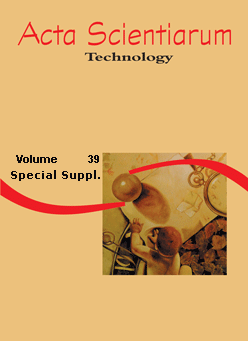<b>Analysis and design of reinforced concrete deep beams using the stress fields method
DOI:
https://doi.org/10.4025/actascitechnol.v39i5.28409Palavras-chave:
stress field method, Strut-and-Tie Method, Jconc, D regions, deep beams.Resumo
Bernoulli's hypothesis facilitates the understanding of some structural elements. However, this hypothesis cannot be applied for some special regions, denominated `D regions´ or `Discontinuity regions´. Deep beams are usually classified into this category and, for this reason, the Brazilian structural code (Associação Brasileira de Normas Técnicas [ABNT], 2014) proposes the design of these elements using Strut-and-Tie Method (STM), which is based on forces acting in hypothetical truss models. Different from the Strut-and-Tie Method (STM), the Stress Field Method (SFM) is based on the knowledge of the stresses acting inside of a structure. Both methods have the same purpose, identify the load carrying mechanisms inside of a complex region. In order to evaluate the potential of the so-mentioned methods, the Jconc software package, which is based on the Non-Linear Elastic-Plastic Stress Fields (NL-EPSF), was applied for the design and analysis of some deep beams. Based on some validations and comparisons, it was possible to propose a solution based on the SFM for the analysis, design, and detailing of deep beams. Finally, the parameters established by the ABNT (2014) for the deep beams were evaluated based on the simulations.
Â
Downloads
Downloads
Publicado
Como Citar
Edição
Seção
Licença
DECLARAÇíO DE ORIGINALIDADE E DIREITOS AUTORAIS
Declaro que o presente artigo é original, não tendo sido submetido í publicação em qualquer outro periódico nacional ou internacional, quer seja em parte ou em sua totalidade.
Os direitos autorais pertencem exclusivamente aos autores. Os direitos de licenciamento utilizados pelo periódico é a licença Creative Commons Attribution 4.0 (CC BY 4.0): são permitidos o compartilhamento (cópia e distribuição do material em qualqer meio ou formato) e adaptação (remix, transformação e criação de material a partir do conteúdo assim licenciado para quaisquer fins, inclusive comerciais.
Recomenda-se a leitura desse link para maiores informações sobre o tema: fornecimento de créditos e referências de forma correta, entre outros detalhes cruciais para uso adequado do material licenciado.



















